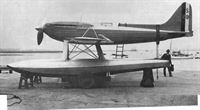Фотографии
-
Регистрационный номер: N248, S1595, S1596 [3] READY FOR ANYTHING: The three British Schneider machines on Sunday morning, September 13, 1931. Farthest away is Boothman's S 6B, S 1595. In the centre, the S 6A, N 248, and in the foreground the S 6B, S 1596, on which Flight-Lieutenant G. H. Stainforth established a new world's speed record of 610-01 km. h. (379-05 m.p.h.) over the 3 km. course in Southampton Water.
Самолёты на фотографии: Supermarine S.5 / S.6 - Великобритания - 1927
-
Регистрационный номер: N247 [2] Fine taxying shot of Supermarine S.6 N247, the winning aircraft in the 1929 Schneider Contest.
Supermarine S.6 N247, powered by a 1,900 h.p. Rolls-Royce R, raised the World Speed Record to 357-7 m.p.h. on September 12, 1929.Самолёты на фотографии: Supermarine S.5 / S.6 - Великобритания - 1927
-
Регистрационный номер: N247 [2] Supermarine S.6 N247 afloat at Calshot shortly after its completion in August 1929.
Самолёты на фотографии: Supermarine S.5 / S.6 - Великобритания - 1927
-
Регистрационный номер: S1596 [3] S1596, the second of the improved S.6Bs, fitted with a 2,330 h.p. R engine.
Самолёты на фотографии: Supermarine S.5 / S.6 - Великобритания - 1927
-
Регистрационный номер: S1596 [3] Гидросамолет S.6B N S1596 - собрат самолета, выигравшего в 1931 году Кубок Шнейдера. На этой машине лейтенант Джордж Стейнфорт 29 сентября 1931 года установил абсолютный мировой рекорд скорости - 655,87 км/ч.
S1596 shows off the S.6B's profile. The huge floats, necessary to support the heavier engine and counteract its increased torque, also contained the main fuel tanks.Самолёты на фотографии: Supermarine S.5 / S.6 - Великобритания - 1927
-
The S.6B's frontal area was kept to an absolute minimum in the quest for drag reduction.
Самолёты на фотографии: Supermarine S.5 / S.6 - Великобритания - 1927
-
18 CYLINDERS AND HOW MANY H.P.? The Isotta-Fraschini engine in the Macchi M.67 s is of the "Broad arrow" type, with 6 cylinders in each bank.
Italy flew two Macchi M.67s in the 1929 contest. The view shows the type's 1,800 h.p., 18-cylinder Isotta-Fraschini engineСамолёты на фотографии: Macchi M.39/M.52/M.67 - Италия - 1926
-
M.67 No 10, piloted in the contest by Lt G. Monti, departs for its navigability trials before the race. In the event only one Italian entry was to complete the requisite seven laps.
Самолёты на фотографии: Macchi M.39/M.52/M.67 - Италия - 1926
Статьи
- -
- Douglas SBD-5 Dauntless N670AM/Bu No 28536 /Preservation Profile/
- Personal album. Civil
- Personal album. Military
- A.Ebbers - Bird Dog. The last affordable warbird
- A.Lumsden, T.Heffernan - Per Mare Probare (15)
- B.Livingstone - Strine Nine
- F.Hislop - Memories (1)
- G.Levett - From Penguin into Eagle (4)
- H.Levy - Travel Air 4-D
- J.Meadows - A Decisive Factor (4)
- J.Stroud - Wings of Peace
- M.Oakey - Grapevine
- R.Swain - Lincoln Rigger
- S.Harding - The Reluctant Dominator (2)







